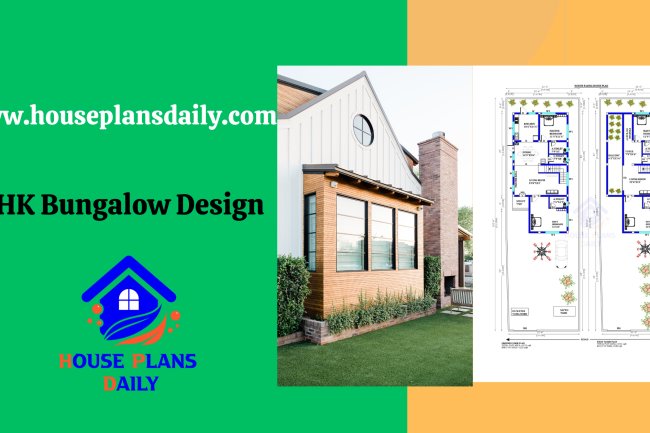North and West Facing House Plans
Discover the best North and West facing house plans for optimal orientation. Find useful tips and designs to maximize natural light and energy efficiency. Visit our website for more options.
Unlocking the Secrets of North and West Facing House Plans
Are you considering building or buying a new home? If so, it's essential to understand the significance of home orientation, particularly when it comes to the direction your house faces. North and west facing house plans have become increasingly popular, and for good reason. These orientations offer numerous benefits that can transform your living experience and enhance your overall well-being.
In this article, we will delve into the secrets of north and west facing house plans, revealing how they can bring more natural light, warmth, and balance to your home. Whether you're seeking a home that is energetically balanced or wanting to minimize energy consumption, understanding the importance of home orientation is key.
Discover the beauty of north and west facing house plans and learn how to optimize your home's design to harness the full potential of natural light and thermal benefits. We will explore practical tips, scientific explanations, and real-life examples to help you create a brighter and more balanced living space. Don't miss out on unlocking the secrets that can bring harmony and happiness into your home.

northwest home
Understanding the importance of house orientation
When it comes to designing or choosing a home, the orientation plays a crucial role in determining the overall comfort and energy efficiency of the space. House orientation refers to the direction in which the main living areas and windows face. North and west facing house plans have gained popularity due to their ability to maximize natural light and thermal benefits.
North-facing house plans are designed to take advantage of the sun's path throughout the day. With the main living areas and windows facing north, these homes can capture ample sunlight, creating bright and inviting spaces. On the other hand, west-facing house plans focus on harnessing the afternoon sun, providing warmth and a cozy atmosphere.
North-facing house plans: advantages and considerations
North-facing house plans offer several advantages that make them highly desirable for homeowners. One of the primary benefits is the abundance of natural light that fills the space. The north-facing windows allow sunlight to penetrate deep into the home, reducing the need for artificial lighting during the day.
Another advantage of north-facing house plans is the consistent temperature control. With the main living areas facing north, these homes can maintain a more stable temperature throughout the year. In colder climates, the warm winter sun can help heat the home, while in warmer climates, shading devices can be used to prevent overheating.
When considering a north-facing house plan, it's essential to take into account the specific site conditions. Factors such as the location of neighboring buildings, trees, or other obstructions can affect the amount of sunlight that reaches your home. Proper site analysis and design adjustments can help mitigate these potential issues and optimize the benefits of a north-facing house plan.
West-facing house plans: advantages and considerations
West-facing house plans offer a unique set of advantages that cater to homeowners looking to create a cozy and warm living environment. One of the significant advantages of west-facing house plans is the stunning sunset views. Imagine relaxing in your living room and witnessing the vibrant colors of the sunset painting the sky each evening.
Another advantage of west-facing house plans is the opportunity to create outdoor living spaces that are perfect for entertaining or enjoying the afternoon sun. Patios or decks facing west can be designed to provide shade during the hottest parts of the day, allowing you to make the most of your outdoor space.
However, it's crucial to consider the potential challenges associated with west-facing house plans. The afternoon sun can be intense, leading to increased heat gain and potential glare. Careful planning and the use of shading devices such as awnings or blinds can help mitigate these issues and ensure a comfortable living environment.

1700 square feet house
Maximizing natural light in north and west-facing homes
Natural light has a significant impact on our well-being and the overall ambiance of a space. When designing or choosing a north or west-facing house plan, maximizing natural light should be a top priority. Here are some tips to help you make the most of the available sunlight:
1. Optimize window placement: Strategic placement of windows can maximize the amount of natural light that enters your home. Consider the position of the sun throughout the day and place windows where they can capture the most sunlight.
2. Use reflective surfaces: Incorporating reflective surfaces such as mirrors or glossy finishes can help bounce light around the room, creating a brighter and more open feel.
3. Choose light-colored walls and furnishings: Light colors reflect light better than dark colors. Opt for light-colored walls, furniture, and accessories to enhance the natural light in your home.
By implementing these strategies, you can create a bright and inviting living space that harnesses the full potential of natural light.
Incorporating passive solar design in north and west-facing house plans
Passive solar design is a sustainable approach to building that utilizes the sun's energy to heat and cool the home naturally. When designing a north or west-facing house plan, incorporating passive solar design principles can enhance energy efficiency and comfort. Here are some key considerations:
1. Solar heat gain: Positioning windows strategically to allow for solar heat gain during the winter months can help reduce heating costs. South-facing windows can be used to capture the most sunlight.
2. Thermal mass: Incorporating materials with high thermal mass, such as concrete or stone, can help absorb and store heat from the sun, releasing it slowly when needed.
3. Insulation: Proper insulation is crucial in any home, but it becomes even more important in north and west-facing house plans. High-quality insulation can prevent heat loss in the winter and reduce heat gain in the summer.
By integrating passive solar design principles into your home, you can create a comfortable and energy-efficient living environment that reduces your carbon footprint.

modern duplex house plan
Landscaping tips for north and west-facing homes
The landscaping around your home plays a significant role in optimizing the benefits of a north or west-facing house plan. Here are some landscaping tips to enhance the overall comfort and aesthetic appeal of your home:
1. Strategic tree placement: Planting deciduous trees on the west side of your home can provide shade during the summer months, reducing heat gain. In the winter, when the leaves have fallen, the trees allow sunlight to penetrate and warm your home.
2. Creating outdoor living spaces: Designing outdoor living areas such as patios or decks can extend your living space and provide a comfortable area to enjoy the natural surroundings.
3. Utilizing natural windbreaks: If your home is exposed to strong winds, consider incorporating natural windbreaks such as hedges or shrubs to create a more sheltered outdoor environment.
By carefully planning your landscaping, you can create a harmonious connection between your home and the natural environment.
Choosing the right window treatments for north and west-facing windows
Window treatments not only enhance the aesthetics of your home but also play a crucial role in controlling light, privacy, and temperature. When selecting window treatments for north and west-facing windows, consider the following factors:
1. Light control: Choose window treatments that allow for flexible light control. Sheer curtains or blinds can be used to filter sunlight while maintaining privacy.
2. Insulation: Look for window treatments with insulating properties to reduce heat gain in the summer and heat loss in the winter.
3. UV protection: Consider window treatments that offer UV protection to prevent fading of furnishings and artwork caused by direct sunlight.
By choosing the right window treatments, you can enhance the functionality and comfort of your north or west-facing home.
Designing outdoor spaces for north and west-facing homes
Outdoor spaces are an extension of your home and an opportunity to connect with nature. When designing outdoor spaces for north and west-facing homes, consider the following:
1. Sun and shade balance: Design your outdoor areas to provide a balance of sun and shade. This allows you to enjoy the warmth of the sun while having areas of respite from direct sunlight.
2. Privacy: Incorporate landscaping features, such as hedges or screens, to create privacy in your outdoor spaces.
3. Outdoor lighting: Install outdoor lighting to extend the usability of your outdoor areas into the evening. Well-placed lighting can create a warm and inviting atmosphere.
By thoughtfully designing your outdoor spaces, you can create an oasis that complements your north or west-facing home.
Balancing temperature and energy efficiency in north and west-facing homes
Maintaining a comfortable temperature and minimizing energy consumption are essential considerations for any homeowner. In north and west-facing homes, balancing temperature and energy efficiency can be achieved through the following strategies:
1. Insulation: Ensure your home is properly insulated to prevent heat loss in the winter and heat gain in the summer. High-quality insulation helps maintain a consistent temperature year-round.
2. Ventilation: Implementing effective ventilation systems, such as ceiling fans or natural cross ventilation, can help regulate temperature and reduce reliance on air conditioning.
3. Shading devices: Install shading devices such as awnings, blinds, or shades to block direct sunlight during the hottest parts of the day and prevent overheating.
By adopting these strategies, you can create a comfortable and energy-efficient living environment in your north or west-facing home.

















